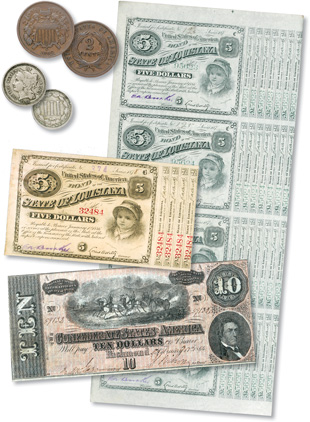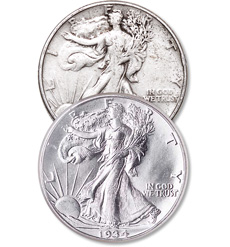Starting Your First Coin Collection
Identifying an area of interest

Your first collection could include coins, paper money, or a combination of both.
The initial step in building your first coin collection is to identify an area of interest. Are you interested in collecting coins, paper money, or a combination of both? Whatever you choose, there are several ways to determine an area of focus. Some new coin collectors concentrate on particular denominations, such as dimes, quarters or $1 coins – or perhaps $1, $5 or $10 currency notes. Other collectors focus on a particular composition – copper, nickel, silver or gold. If you like coins or paper money with geographical interest, you might collect Statehood quarters, or obsolete National Bank Notes bearing the names of local banks. You may also enjoy collecting coins from around the world or from ancient times. If unique and unusual issues interest you, a collection of error coins and varieties might include the 1937-D Three-Legged Buffalo nickel (missing a leg), the 1955/55 Doubled Die cent (with a blurred double image), and the short-lived 1909 V.D.B. Lincoln cent with prominent designer initials.
Determining your budget
Determining how much you want to spend on your hobby is an important decision. In general, a complete collection of an older or longer series of coins costs more than a briefer or more recent series (a complete collection of 1913-1938 Buffalo nickels is more costly than a complete collection of 1971-1978 Eisenhower dollars). In addition, each series features Key Dates – especially scarce or low-mintage issues that are keys to completing the series and command a premium among collectors. The composition of coins is also a major factor in their price, as silver and gold issues reflect the intrinsic or bullion value of the coins.
You should also include the cost of display albums, holders and other hobby accessories in your budget – and leave room to expand your collection as you discover new favorite issues and areas of interest. Littleton's Collector Clubs are a popular way to stay within a budget, allowing you to assemble a complete series collection with affordable monthly shipments, and including free or discounted archival-quality albums.
To learn more about storage options, handling, and cleaning, please see Caring for Your Coins or Caring for Your Paper Money.

Note the difference in detail on these Liberty Walking half dollars, graded Fine 12 (top) and Gem Uncirculated 65.
Deciding on grades
Grading is a measurement of the physical condition of a coin or bank note – its state of preservation in relation to new original condition. Most collectors prefer well-preserved coins or paper money, because more of the original detail, finish or color is present. The higher the grade, the higher the price. Littleton's Grading Guides define the range of grades for both coins and paper money.
It's often advisable to begin a new collection of coins or paper money with some less-expensive, lower-grade issues, until you're certain of your level of interest. You can always upgrade your collection over time as your budget allows.
Selecting items for your collection
The greatest danger to a collector is buying mis-described material; it may be over-graded, or badly mis-attributed. To avoid acquiring a poor sample coin, it is helpful to learn about grading so you can objectively define a coin's value. Our easy-to-use grading guides can get you started.
No matter your level of expertise, one of the keys to success is to be selective. Developing your eye for quality is critical. Don't be in a hurry. Take your time to examine a lot of coins or notes before you buy. Spend small amounts of money at first, and analyze the results before you move on to higher levels. If you plan on starting a coin collection, the following guidelines will be especially helpful:
- Look for coins with eye appeal. Whether a coin is well-worn or Uncirculated, there are some commonalities that you should look for in selecting a nice coin regardless of the date or mint mark. The number one thing we look for is "eye appeal." Look for pleasing coins with a look that will "fit" with your other coins. Stay on this course, and at the end of the day, you'll have a matched collection with eye appeal.
- Look for originality. How do you find that coin with eye appeal? Ideally, the surfaces of the coin should be original. For example, for a circulated silver coin you want a light to medium grey coloration. Unless you like shiny coins, avoid coins that have been cleaned or polished. The coin should have no major scratches, or rim problems. Don't forget to examine and grade the edge – the third side of the coin.
- Look for quality. With circulated coins, striking is not an issue until you get into the higher grades of circulated. However striking is very critical in Uncirculated grades and even more critical for certain dates that are notoriously poorly struck. Eye appeal is even more important in the Uncirculated grades, the higher the grade the more important. But even if you are buying MS-60 coins, technically "new" coins but obviously bag-marked to varying degrees, eye appeal is still critical to present enjoyment and future value. Stay away from heavily bag-marked coins. Look for pleasing surfaces. Avoid pieces with heavy fingerprints, or coins that are heavily bag-marked.
Luster is also very important with Uncirculated coins, and an important ingredient in eye appeal. Look for a coin with "life" to it. Avoid coins with a dull, washed-out look. If you like toned coins, look for transparent, light toning, where you can still see the detail and surfaces clearly.
Setting goals for your collection
Having a goal or objective in mind is always a good idea. Then you'll closely follow your collecting interests, and you'll stay within your budget. Larger goals might include a complete date and mint mark collection of Lincoln cents, or every signature combination found on Silver Certificates. Smaller collecting goals could be one Lincoln cent from each year of issue (1909 to the present), or one note of each Silver Certificate denomination.
Keep in mind that there are limitless ways to collect coins and create your own personalized collection. Your hobby should be fun and relaxing, as well as educational and exciting! Just remain flexible and see where your interests take you. Small goals can turn into larger goals, and every coin or currency note will add interest to your collection!

